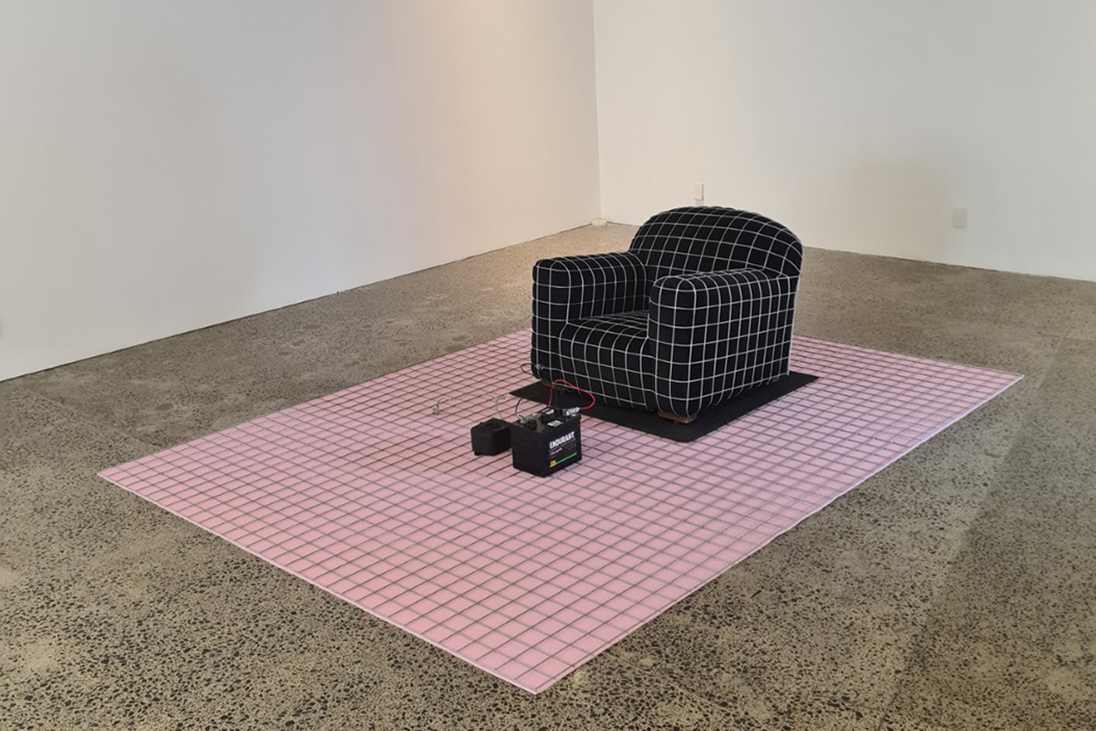CHAIR
installation 1973 - 2019
 Door, window, world - 2023
Door, window, world - 2023



Anderson-Rhodes Gallery - 2019
installaton remake - original chair and electric fence unit
Chair
installation (various media - gal.steel grid, sheet foam, arm chair, rubber mat, 6v battery, electric fence unit)
Door, window, world: Maree Horner, J.C. Sturm; Artspace Aotearoa, Tāmaki Makaurau-Auckland, 11 February-6 April, 2023
Artspace Aotearoa ︎︎︎
Victoria Wynne-Jones - Art Now ︎
Anderson Rhodes Gallery, Ngāmotu-New Plymouth, 2019
Maree Horner’s Chair is a remake of a 1973 installation undertaken during her Master’s degree at Elam School of Fine Arts in Auckland.
As well as the modifications required to adapt Chair to a different venue, the materials and componentry have evolved in the 45 years since its first incarnation. The challenges posed by these changes and the solutions sought have become an intregal part of the process for Maree and are now woven into the work’s unfolding history.
The initial presentation had the installation in a generous room with space to circulate its perimeter, but here it’s constrainted by the floor size available - a modest gallery up a flight of stairs. Rather than distracting from the experience, it heightens it: the disquiet, the ominous, and the curiousness seem even more profound.
installation 1973
![]()
The Chair is over sized and comfortable, but covered in steel mesh. It sits vacant on a 14' x 10' area of the same mesh on top of pink foam. A 6 volt battery and an electric fence unit sit in front of the chair and are connected to it and the floor area. A current pulses through the chair, while the floor is only for earthing and could be walked onto. The piece is very silent except for a quiet continuous tick, tick.
I was thinking about suburban neurosis and the person who sits in a comfortable chair and doesn't think about anything. Ironically this could be turned on myself.
In order to keep the cats off, my father used to electrify his car every night with a battery and an electric fence unit like I used in the chair. I liked that idea and that image.
installation (various media - gal.steel grid, sheet foam, arm chair, rubber mat, 6v battery, electric fence unit)
Door, window, world: Maree Horner, J.C. Sturm; Artspace Aotearoa, Tāmaki Makaurau-Auckland, 11 February-6 April, 2023
Artspace Aotearoa ︎︎︎
Victoria Wynne-Jones - Art Now ︎
Anderson Rhodes Gallery, Ngāmotu-New Plymouth, 2019
Maree Horner’s Chair is a remake of a 1973 installation undertaken during her Master’s degree at Elam School of Fine Arts in Auckland.
As well as the modifications required to adapt Chair to a different venue, the materials and componentry have evolved in the 45 years since its first incarnation. The challenges posed by these changes and the solutions sought have become an intregal part of the process for Maree and are now woven into the work’s unfolding history.
The initial presentation had the installation in a generous room with space to circulate its perimeter, but here it’s constrainted by the floor size available - a modest gallery up a flight of stairs. Rather than distracting from the experience, it heightens it: the disquiet, the ominous, and the curiousness seem even more profound.
︎ Acquired for the AAG permanent collection, 2020
installation 1973

The Chair is over sized and comfortable, but covered in steel mesh. It sits vacant on a 14' x 10' area of the same mesh on top of pink foam. A 6 volt battery and an electric fence unit sit in front of the chair and are connected to it and the floor area. A current pulses through the chair, while the floor is only for earthing and could be walked onto. The piece is very silent except for a quiet continuous tick, tick.
I was thinking about suburban neurosis and the person who sits in a comfortable chair and doesn't think about anything. Ironically this could be turned on myself.
In order to keep the cats off, my father used to electrify his car every night with a battery and an electric fence unit like I used in the chair. I liked that idea and that image.
From:
new art - Some recent NZ sculpture and post-object art
edited by Jim Allen & Wystan Curnow
Pbl Heinemann (1976)